3—
Stravinsky Re-Barred
Music Criticism
The idea that in passages of metric irregularity meter and phrase might often coincide in some characteristically Stravinskian fashion (that, in other words, the barring might here often represent a localized form of phrasing or grouping) is not especially new. Well before publication of the composer's recollections in Expositions and Developments, critics had come to roughly the same conclusions about the rhythmic phenomenon. The difference, however, was that these earlier conclusions were drawn up in the form of an indictment. The one-dimensional implications of this meter-phrase coincidence were viewed as an impoverishment.
It need hardly be remarked in this connection that the opinions of critics such as Cecil Gray and Constant Lambert are today of little or no consequence. Certainly the general tone of this early English commentary is pompous in the extreme. While Lambert's Music Ho! A Study of Music in Decline (1934)[1] is at times subtle and entertaining, and a good deal more compelling than Gray's earlier A Survey of Contemporary Music (1924),[2] both Lambert and Gray project a puffy, know-it-all image that is difficult to shake. Nor are the musical heroes of these critics—Delius for Gray, Sibelius for Lambert—likely to inspire confidence, especially as these affections come at the expense, in devastating detail, of nullities such as Debussy,
[1] (London: Faber and Faber; 3d ed. 1966).
[2] (Oxford: Oxford University Press, 1924).
Schoenberg, and Stravinsky. Of course, verdicts in music criticism need not count for much—"opinions are mostly worthless," as Virgil Thomson once observed.[3] Listeners familiar with the music and musical issues at stake are more likely to be taken by the descriptive details of an argument than by its judgmental bias; often enough, details pursued on behalf of a negative assessment can just as easily be weighed in favor of the sympathetic vote, and the very traits isolated and decried by the detractors can become the ones that admirers most admire. What is interesting is that Gray and Lambert erected a critical edifice that has in one way or another served as a point of departure for nearly all subsequent critiques of Stravinsky's music. Even Theodor Adorno, intellectually a more acceptable figure nowadays, can add little to the general impression of the music as conveyed by Gray and Lambert. Most appropriately, all three critics—Gray, Lambert, Adorno—are not in the least hesitant about directing their attention to that single dimension in which Stravinsky's impact has most readily been felt, namely, that of rhythm.
As a general premise, rhythmic "effect" is seen as a net loss, since it disrupts the balance of the classics, an idealized equilibrium between melody, harmony, rhythm, and timbre. An emphasis on one of these components can come only at the expense of the others.
Although it is often convenient for the purposes of criticism and analysis to speak of musical language as if it were made up of three or four separate and independent elements in combination—melody, harmony, rhythm, and possibly . . . color—we must be careful not to think of it as such. As long as we make use of these terms in order to define more accurately certain qualities in certain works, they are quite legitimate and sometimes even necessary, but that is all. In actual fact it is impossible to conceive of one without the others. They are interdependent and indissoluble. . . . Not only, however, are these component elements inseparable from each other, but each is at its highest when they are all in complete equilibrium, when one does not predominate over the others. In the music of the greatest masters . . . one will find this perfect balance and equipoise; you cannot say of this music that it is "harmonic," "rhythmic," or "melodic"; it is all and it is none. But the moment that one element grows at the expense of the others the perfect concord is broken or impaired.[4]
Melody is the first casualty. In Gray's words, Stravinsky's melodic style, "short and monotonous," consists in the main of "a ceaseless alternation between two or three notes."[5] (The "Evocation of the Ancestors," Examples 9 and 10 in Chapter 2, comes readily to mind, as do the opening pages of Les Noces . Years later, apropos of a few measures from the Elegy to J. F. K. (1964), Stravinsky him-
[3] A Virgil Thomson Reader (Boston: Houghton Mifflin, 1981), p. 187.
[4] Cecil Gray, A Survey of Contemporary Music , pp. 137–41.
[5] Ibid., p. 143.
self acknowledged the two- or three-note alternation as "a melodic-rhythmic stutter characteristic of my speech from Les Noces to the Concerto in D [1947], and earlier as well—a lifelong affliction, in fact.")[6] More to the point, for Gray the emphasis on rhythm led not only to "an impoverishment of melody and harmony, but to the loss of the very quality to which [Stravinsky] sacrificed the other two—rhythmic vitality." Divorced by sheer "effect" from its sister components, rhythm stiffened into design or pattern; it "degenerated into meter."[7]
The moment [rhythm] is divorced from the other constituent elements of musical speech it changes its character; it stiffens, petrifies, and becomes lifeless—becomes meter . In much the same way that formal design and rhythm when they cease to be representative tend, inevitably, automatically, to become mere geometrical pattern, as in a wallpaper or carpet, so musical rhythm, divorced from melodic implications, also becomes inert, lifeless, mechanical, metrical .[8]
So Stravinsky's obsession with rhythm in the Sacre has led, not only to the impoverishment of both harmony and melody, but to the loss of the very quality to which he sacrificed the other two—rhythmic vitality. The Sacre du Printemps, so far from being the triumphant apotheosis of rhythm, the act of restoration to its rightful supremacy of the most important and essential element of musical expression, is the very negation and denial of rhythm. In sacrificing everything to it, Stravinsky has, with admirable poetic justice, lost it, along with its companions, as well. Rhythm has here degenerated into meter.[9]
Gray follows this with an account of the "Sacrificial Dance."
Even those sections of the Sacre which give the impression of complexity, such as the final dance of the Elect, in which every musical interest is sacrificed to rhythmical purposes, are very primitive in construction. The time-signature changes constantly from bar to bar, but the music itself does not; it is only the eye and not the ear which perceives the changes. There is nothing there but the incessant reiteration of the same insignificant metrical phrase in slightly varying quantities. . . . Strip the music of the bar-lines and time-signatures which are only loincloth concealing its shameful nudity, and it will at once be seen that there is no rhythm at all. Rhythm implies life, some kind of movement or
[7] C. Gray, A Survey of Contemporary Music , p. 140.
[8] Ibid., p. 139. (Italics added.)
[9] Ibid., p. 142. (Italics added.)
progression at least, but this music stands quite still, in a quite frightening immobility. It is like a top or gyroscope turning ceaselessly and ineffectually on itself, without moving an inch in any direction, until, in the last bars of the work, it suddenly falls over on its side with a lurch, and stops dead.[10]
The description here of paradox, of seeming "rhythmic vitality" that conveys an overall impression of stasis or "frightening immobility," is entirely apropos. So, too, is the sense of futility that accompanies the conception of "a top or gyroscope turning ceaselessly and ineffectually on itself." A rhythm that, outwardly restless, conveys little overall sense of "movement or progression" is in fact one of the more striking aspects of Stravinsky's invention, acknowledged in these terms by countless critics on both sides of the fence, and a topic to which we shall eventually be returning for further discussion. An early admirer of Stravinsky's music, André Schaeffner, likewise pointed to "the rigid, solemn, priestly, petrified, or gilded" aspect of Stravinsky's art, to "a fixed, hieratic, mummified quality" that seemed "so paradoxical in a musician whose richness of rhythmic invention is undeniable."[11]
Many of Gray's arguments are rephrased by Lambert. There is, initially, the sense of a "dissociation" of rhythm "from its melodic and harmonic components," leading in turn to a "short-winded" melodic style.[12] Indeed, for Lambert it is "the lack of a melodic faculty," the apparent inability of this composer to chisel a melodic substance of his own (to create "a typical Stravinskian tune"), that provoked the stylistic upheaval of neoclassicism, the abrupt move from the borrowed or fabricated folk tunes of the "Russian" era ("monotonous peasant fragments") to the comic rewriting of Pergolesi in Pulcinella .[13] And here, too, rhythmic "effect" and its consequent "dissociation" tend merely "to restrict the development of the specific element" favored.[14] Rhythm deteriorates into meter or "mathematical groupings."
[10] Ibid., pp. 142–43.
[11] André Schaeffner, "On Stravinsky, Early and Late," Modern Music 12, 1 (1934): 2–3. See also, in this connection, André Schaeffner, Strawinsky (Paris: Rieder, 1931). Two equally sympathetic accounts were published at the time of Schaeffner's biography: Boris de Schloezer, Igor Stravinsky (Paris: Editions Claude Aveline, 1929), and Paul Collaer, Strawinsky (Brussels: Editions Equilibres, 1930). Eric Walter White, Stravinsky's Sacrifice to Apollo (London: Hogarth Press, 1930), should be mentioned as an early enthusiastic appraisal on the other side of the channel.
[12] Lambert, Music Ho , p. 91. Following Gray and Lambert, the idea that Stravinsky lacked a "melodic gift" became a proverbial lament among detractors. Humphrey Searle dubbed the composer "a poor melodist" in Twentieth Century Counterpoint (London: Williams and Norgate, 1954), pp. 29–30, while Donald C. Mitchell, although on the whole an enthusiast, pointed similarly to "a crisis in melody," in The Language of Modern Music (New York: St. Martin's Press, 1963), p. 144. For a brief rebuttal see van den Toorn, The Music of Igor Stravinsky , pp. 237–38.
[13] Lambert, Music Ho , pp. 97–98.
[14] Ibid., p. 49.
Stravinsky's rhythm is not rhythm in the true sense of the term, but rather "meter" or "measure." In many sections of Le Sacre the notes are merely pegs on which to hang the rhythm.[15]
Histoire consists almost entirely of an objective juggling with rhythm, or rather meter, for there can be no true rhythm where there is no melodic life. Like Gertrude Stein, Stravinsky chooses the drabbest and least significant phrases for the material of his experiments, because if the melodic line had life, dissection would be impossible. . . . The melodic fragments in Histoire are completely meaningless in themselves. They are merely successions of notes which can conveniently be divided up into groups of three, five, and seven, and set against other mathematical groupings.[16]
In most if not all of these particulars, Adorno follows suit. True, the argument acquires a Marxist and Freudian rationale. Yet, here too, Adorno's comments are not altogether new. Gray also complained about the "infantilism" of some of the shorter "Russian" pieces such as the Berceuses du chat and Pribaoutki and portrayed the composer's celebrated wit and irony as something "wholly negative," a kind of "grin" which, when compared to "the ghastly inhuman laughter of Schoenberg's Pierrot Lunaire ," was "mere cynicism," an empty, "meaningless dog-laugh."[17] And he ridiculed the aesthetics of "abstraction" along with the composer's "absurd feats of austerity" (which for Adorno became "renunciation" or "a perverse joy in self-denial"),[18] referring the reader for further study "to Professor Sigmund Freud's treatise on the 'Resemblances between the Psychic Life of Savages and Neurotics.'"[19] Here follow Adorno's comments on Stravinsky "the rhythmist," where reference is again made to the element of "dissociation" and its adverse consequences.
Stravinsky's admirers have grown accustomed to declaring him a rhythmist and testifying that he has restored the rhythmic dimension of music—which had been overgrown by melodic-harmonic thinking—again to honor. In contrast it has been rightly asserted by the Schoenberg school that the rhythmic concept—for the most part manipulated much too abstractly—is constricted even in Stravinsky. Rhythmic structure is, to be sure, blatantly prominent, but this is achieved at the expense of all other aspects of rhythmic organization. Not only is any subjectively expressive flexibility of the beat absent—which is always rigidly carried out in Stravinsky from Sacre on—but furthermore all
[15] Ibid., pp. 49–50.
[16] Ibid., p. 93.
[17] Gray, A Survey of Contemporary Music , 133–34.
[18] Theodor W. Adorno, Philosophy of Modern Music , trans. Anne G. Mitchell and Wesley V. Bloomster (New York: Seabury Press, 1973), p. 145.
[19] Gray, A Survey of Contemporary Music , p. 145.
rhythmic relations associated with the construction, and the internal compositional organization—the "rhythm of the whole"—are absent as well. Rhythm is underscored, but split off from musical content. This results not in more, but rather in less rhythm than in compositions in which there is no fetish made of rhythm; in other words, there are only fluctuations of something always constant and totally static—a stepping aside—in which the irregularity of recurrence replaces the new.[20]
Note the allusion here to the mechanical character of the invention, to the fact that it does not admit "any subjectively expressive flexibility of the beat," a matter to which we shall likewise be returning for additional comment. Crucial to Adorno as well is the static nature of rhythm's "dissociation," its splitting-off "from musical content." For whether the shifting accents occur within periods of metric regularity or whether, in passages of irregular barring, the material is dissected or sliced up into smaller "melodic cells" that are in turn reshuffled and varied in length, a true sense of progress or development is replaced by "mere repetition."[21] "There are only," as he says, "fluctuations of something always constant and totally static."
The most elementary principle of rhythmic variation—which is the basis of repetition—is that the motif be constructed in such a way that, if it immediately reappears, the accents of their own accord fall upon notes other than they had upon first appearance (for example, "Jeu de Rapt" in Sacre ). Frequently, not only are accents shifted, but length and brevity are interchanged as well. In all cases, the differentiations derived from the motivic model appear to be the result of a simple game of chance. In this perspective, the melodic cells seem to be under a spell: they are not condensed, rather they are thwarted in their development.[22]
The school rooted in Stravinsky has been called motoric. The concentration of music upon accents and time relationships produces an illusion of bodily movement. This movement, however, consists of the varied recurrence of the same: of the same melodic forms, of the same harmonies, indeed of the very same rhythmic patterns. Motility . . . is actually incapable of any kind of forward motion.[23]
Most serious in this indictment is the charge of arbitrariness. "The modifications of accents . . . could in all cases just as well be fixed in another way."[24] In this
[20] Adorno, Philosophy of Modern Music , pp. 154–55. (Italics added.)
[21] Ibid., p. 164.
[22] Ibid., p. 151.
[23] Ibid., p. 155.
[24] Ibid.
sense they are "abstract irregularities" that, "void of traditional meaning," constitute a kind of "arbitrary game," a "game of chance." (Gray pictured them as "geometrical pattern, as in wallpaper or carpet," while for Lambert the "abstract" patterns defined by the irregular or shifting accents were "rhythmical jigsaw puzzles.") Thus, too, pursued as ends in themselves (because "dissociated" or "split off from musical content"), the shifting accents were unprepared, and were therefore apt to be experienced as a series of "convulsive blows or shocks." And while the notion of shock is acknowledged as fundamental to much modern music, its implications in Stravinsky are "dehumanizing." Unable to apprehend the logic behind the "abstract irregularities" and hence unable to participate (to anticipate, resist, or absorb), the listener, as if under a spell, became the hapless victim of a kind of barrage. The composer's complicity is termed "sadistic" or "sadomasochistic."[25]
In the "sacrificial dance," the most complicated rhythmic patterns restrain the conductor to puppet-like motions. Such rhythmic patterns alternate in the smallest possible units of beat for the sole purpose of impressing upon the ballerina and the listeners the immutable rigidity of convulsive blows and shocks for which they are not prepared through any anticipation of anxiety.[26]
Everything depends upon the manner in which music deals with the experience of shock. The works of Schoenberg's middle years take up a defensive position by portraying such experiences. In Erwartung . . . the gesticulation recalls a man gripped by wild anxiety. Psychologically speaking, however, the man is saved by his anticipation of anxiety: while shock overcomes him, dissociating the continuous duration of traditional style, he retains his self-control. He remains the subject and, consequently, is able to assert his own constant life above the consequence of shock experiences which he heroically reshapes as elements of his own language. In Stravinsky, there is neither the anticipation of anxiety nor the resisting ego; it is rather simply assumed that shock cannot be appropriated by the individual for himself. The musical subject makes no attempt to assert itself, and contents itself with the reflexive absorption of the blows. The subject behaves literally like a critically injured victim of an accident which he cannot absorb and which, therefore, he repeats in the hopeless tension of dreams.[27]
Arbitrariness—"abstract" design or pattern that is "void of traditional meaning"—is an impression shared by all three critics. And what may have induced this shared response can perhaps be traced to two interrelated factors: (1) the absence, during periods of acute metric irregularity, of an acceptable tactus (that is to say, an
[25] Ibid., p. 159.
[26] Ibid., p. 155.
[27] Ibid., pp. 156–57.
acceptable marking for the beat or unit of pulsation),[28] and (2) the fact that the shifting accents which accompany the irregularity (or which, during periods of regular metric periodicity, disrupt the periodicity) severely compromise melodic identity. In other words, the difficulty seems to have arisen not so much from the absence of a steady meter as from the fact that in the most disruptive cases the irregularity occurred at a subtactus level, at a level below that of a standard (and in some instances preestablished) pulse. One of Adorno's complaints is that the rhythmic patterns in the "Sacrificial Dance" involved "the smallest units of beat," thus restraining the conductor to a series of mechanical, "puppet-like motions." In tonal music, of course, irregularity may routinely be inferred at the hypermeasure levels of metric structure, and even at the level immediately above that of the measure; in Stravinsky's music, irregularity occurs routinely at the level of the measure, coming by way either of the tactus or, as indicated already, note values or "units of beat" below that of a standard or prearranged pulse.
For example, at nos. 37 and 40 in the "Ritual of Abduction," the principal melody of this movement is introduced within a




More subtly, the disruption at no. 46 brings to the foreground those elements, meter and pulse, which in past tonal music are apt to be taken more or less for
[28] Tactus and pulse (or unit of pulsation ) are here used interchangeably. Both refer to that particular level of metrical structure where, in past tonal music, regularity is most stringent, and in accord with which batons are commonly waved, floors are tapped, and steps are danced. Tactus , a Renaissance term, encompasses both the notion of pulse and a standard marking of 70 beats per minute; in past tonal music, the rate has commonly been between 40 and 160 beats. In Fred Lerdahl and Ray Jackendoff, A Generative Theory of Tonal Music , p. 71, these terms are introduced in the following manner: "Musical intuitions . . . clearly include at least one specially designated metrical level . . . the tactus . This is the level of beats that is conducted and with which one most naturally coordinates foot-tapping and dance steps. When one wonders whether to "feel" a piece "in 4" or "in 2," the issue is which metrical level is the tactus. In short, the tactus is a perceptually prominent level of metrical structure."
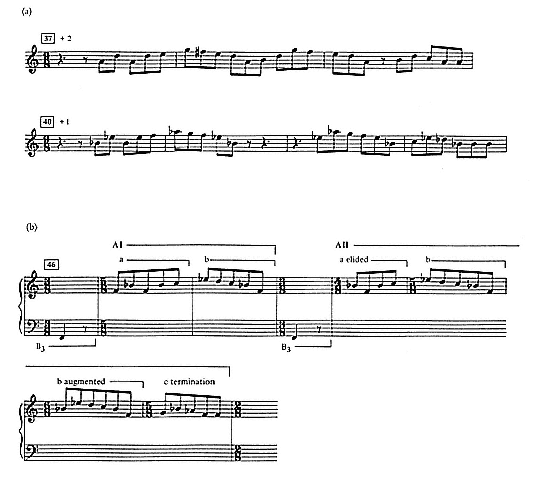
Example 14:
"Ritual of Abduction"
granted on a background, nearly subconscious level of perception. In other words, in first establishing and then disrupting these ingrained levels of metrical structure, passages such as those at no. 46 have the effect of momentarily intensifying their presence. Hence, too, for the above critics, the shared impression of a rhythm that had mechanically stiffened into design, that had "degenerated into meter." The metric irregularity at no. 46 could have come by way of the tactus, the dotted quarter-note at nos. 37–46, and hence by way of extensions or contractions of the



nos. 57–64 in the "Ritual of the Rival Tribes," where, by way of the quarter-note as tactus, the meter alternates among


Unable, then, to identify these elementary terms of reference, unable to rely on the crutch of a steady meter or uniform pulse, critics were understandably at a loss in locating a grain against which the invention could in some meaningful fashion be heard and understood. Nor, by the same token, could they appreciate the contradictions or reversals in the metric identity of the reiterating fragments, chords, configurations, or "cells," since such "displacement" hinges necessarily on these automatic, background terms of reference. Whether acknowledged or unacknowledged by the meter, the patterns defined by the shifting accents or stresses were thus interpreted as "abstract" design, "as in wallpaper or carpet." As music such design was, quite literally, meaningless.
In a curious way, too, all three critics would have found confirmation for their arguments in the analytical excursions of Pierre Boulez.[29] For while Boulez is an admirer of The Rite —while, for Boulez, The Rite is a piece in which rhythm had in fact finally been given its due—his more technical accounts tend merely to document the earlier vision of abstract design and pattern.
Boulez's analysis of the passage at no. 46 in the "Ritual of Abduction" is shown in Example 14b.[30] The outline here is useful because it scans the characteristic block structure prominently in evidence. Two blocks of material, labeled B and A respectively, are placed in an abrupt juxtaposition with one another; Block B, which consists of an F-punctuation spanning a single

[29] Indeed, leaving aside Gray and Lambert as points of departure in music criticism, many of Adorno's descriptions of pitch structure in The Rite come close to those of Boulez. In his Philosophy of Modern Music , p. 151, Adorno emphasizes the "contradiction between the moderated horizontal and the insolent vertical," between the "antiquated" diatonic fragments of the horizontal plane and the harsh dissonance of the vertical. Similarly, in Pierre Boulez, Notes of an Apprenticeship , trans. Herbert Weinstock (New York: Knopf, 1968), p. 74, The Rite is described as a piece in which a "horizontal diatonicism" stands in opposition to a "vertical chromaticism." This is an issue to which we shall be turning in Chapters 5 and 6.
[30] Boulez, Notes of an Apprenticeship , p. 98.
ing"), can properly be gauged. The element of disruption is entirely absent from the carefully enumerated graph of Example 14b.
At the heart of many of these problems is the fact that, like earlier critics, Boulez takes the irregular or shifting meters at face value. Indeed, his extensive analysis of rhythm in The Rite includes no mention at all of the role of steady metric periodicity, even though steady meters govern much of the music in Part I with, by and large, their traditional hierarchical implications intact. Like his predecessors, Boulez tends therefore to ignore the grain against which the disruptive effect of the invention is felt. Rhythm may not here have reached a state of impoverishment, but it remains a one-dimensional affair nonetheless. Attention is drawn to the irregularity and reshuffling of the individual "melodic" or "rhythmic cells," which, acknowledged or unacknowledged by the meter, form the basis of the kinds of designs illustrated in Example 14b. Indeed, all four critics, Gray, Lambert, Adorno, and Boulez, are "radical" interpreters of Stravinsky's music, in the sense in which this term was first introduced by Andrew Imbrie several years ago.[31] What this means is that, in analytical review and hence presumably in perception, they tend to readjust their metrical bearings "radically" at the first signs of conflicting evidence. On the other hand, the instinct of the more "conservative" listener is to cling to an established regularity for as long as possible, and often with the consequence that the effect of conflict or disruption is all the more acutely felt. Thus, too, for the conservative listener, the one-dimensional implications of the meter-phrase coincidence often prove deceptive. For while the irregular barring might indeed often represent a localized phrasing or grouping, the other side of this coin is that it might not in fact reflect the full extent of metrical awareness. It might harbor a preestablished or readily inferable periodicity which guarantees the apprehension of contradiction in metric identity—indeed, that very "displacement" that commentators have been prone to invoke when confronting Stravinsky "the rhythmist."
In contrast to the irregularly barred passage at no. 46, the rhythmic pattern of the celebrated "Augurs of Spring" chord at no. 13 is introduced in a steady

[31] See Andrew Imbrie, "'Extra' Measures and Metrical Ambiguity in Beethoven," in Alan Tyson, ed., Beethoven Studies (New York: Norton, 1973), pp. 45–66. In Beethoven, however, the radical-conservative dichotomy entails reactions to irregularity and disturbance at levels of structure above that of the measure. The notion is reintroduced in Lerdahl and Jackendoff, A Generative Theory of Tonal Music , pp. 23–25, in reference to the opening measures of Mozart's G Minor Symphony. At the two-measure level, the first movement begins with accents on the downbeats of the odd-numbered measures, a formula that is clearly reversed with the restatement of the principal theme at m.20. The authors conclude that the conservative listener might hold on to the established framework until m. 14, while the radical one might promptly readjust with the first signs of conflict at m. 9. These alternatives are labeled "Interpretation A" and "Interpretation B."
[32] Boulez, Notes of an Apprenticeship , p. 91.

Example 15:
"Augurs of Spring"
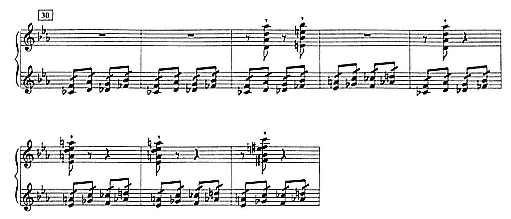
Example 16:
"Augurs of Spring"
His intent is to trace the reappearance and reordering of these "cells" in the varying contexts that lie ahead, and what emerges from his account is the clear sense of a "rhythmic theme," a rhythmic pattern that is in fact "split off from musical content" and that gradually acquires an independent life of its own. The passage of transition at no. 30, although overlooked by Boulez, serves as illustration. Shown in Example 16, the entire eight-measure pattern is lifted from its initial setting at no. 13 and applied to the bridge leading directly to the movement's climactic block at nos. 31–37.
Example 17 shows an even more radical approach. Here the analysis marks off the groupings as defined by the shifting accents, so that in opting for the irregular meter, the analyst (or composer) may be imagined as having "jumped the fence." The eight-measure stretch is split up into irregular bars of



Example 17:
"Augurs of Spring"
seen not to be so if, as in Example 17, a reiterating fragment, taken from no. 46 in the "Ritual of Abduction," is applied.
Missing from these accounts, however, is an appreciation of the role of the steady













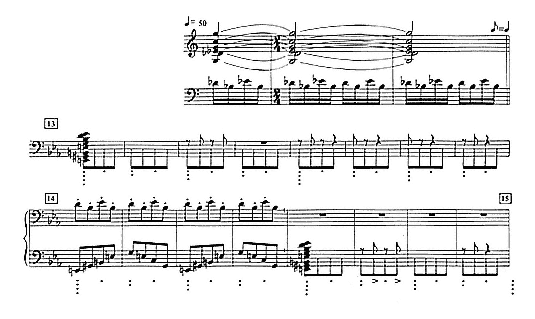
Example 18:
"Augurs of Spring"
note (tactus), measure, and the two- and four-measure units (see Example 18).[33]
Of course, the purpose of these introductory remarks is not to squeeze the variety of rhythmic structure in The Rite —or, indeed, in Stravinsky's music generally—into a single barrel of uniformity. On the contrary, steady meters often imply a construction that, in harmonic, melodic, and instrumental detail, differs fundamentally from that implied by irregular meters, so that a central concern in these chapters will be the identification of two prototypes of construction based on these distinctions. The kind of construction presupposed by the steady meters of "Procession of the Sage" and "Dance of the Earth" is quite different from the block structures that accompany the shifting
[33] In Lerdahl and Jackendoff, A Generative Theory of Tonal Music , p. 18, beats are conceived not as durations but as points in time (analogous to geometrical points in space) which, strongly or weakly accented, are organized hierarchically in a manner that is independent of grouping or phrasing. Hence in their analyses, as here in Example 18, dots are used to represent beats at various levels of a metrical structure. The conception of beats as durationless points in time stems from Arthur J. Komar, Theory of Suspensions (Princeton: Princeton University Press, 1971), p. 52, and from Imbrie, "'Extra' Measures and Metrical Ambiguity in Beethoven," p. 53; the spatial analogy is Imbrie's. It should be added, however, that in A Generative Theory , pp. 19–21, meter is viewed as "inherently periodic" and as "a relatively local phenomenon"; Lerdahl and Jackendoff contend that at higher levels of structure, where the formulation is seldom regular, the sense of meter, of a strong-weak alternation, dims and gives way to large-scale grouping and "thematic parallelism." In contrast, Imbrie's conception of meter allows for greater irregularity, so that in their independent, interacting roles, meter and grouping continue to coexist at higher structural levels.
meters of "Ritual of Abduction" and "Evocation of the Ancestors." And irrespective of the imposed irregularity of Example 17, there are reasons for the steady

Les Noces (1914–23)
When Stravinsky himself first drew attention to the coincidence of meter and phrase in certain passages of irregular barring in The Rite (recalling that in many such instances he had sought "to measure according to phrasing"), he had in mind rather specifically the lengthy, irregular measures of the early sketchbook and printed versions of "Evocation of the Ancestors" and "Sacrificial Dance." Clearly, however, the logic of this coincidence extends to the later application of "smaller divisions" as well. Nor is the progression from large to small confined to the composition and revision of The Rite . An early draft of Les Noces , scored for mezzo soprano, woodwinds, and double string quintet, exhibits the same symptoms in relation to this work's final version of 1917–23.[34]
Labeled A and B, the opening two blocks of Les Noces are reproduced in Examples 19 and 20; Example 19 is from the draft (where the two blocks are set apart by a change in tempo), and Example 20 is condensed from the final version. The earlier version features longer measures of seven, six, and five eighth-note beats that were subsequently sliced up into "smaller divisions" of two and three beats. Nor does the correspondence end here, for the proportions in these two versions of Les Noces are quite different. Just as with the several versions of the "Evocation" examined in Chapter 2, the opening material of Les Noces underwent a process of expansion: Block A is considerably
[34] This early Noces draft is now a part of the Paul Sacher Foundation in Basel, Switzerland. A facsimile of the first page appears in Vera Stravinsky and Robert Craft, Stravinsky in Pictures and Documents (New York: Simon and Schuster, 1978), p. 144.
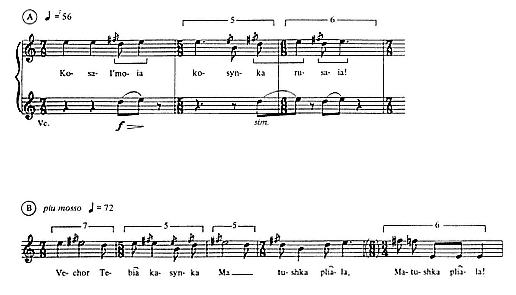
Example 19:
Les Noces (early draft)
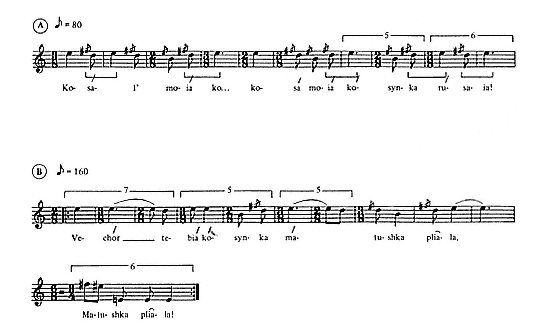
Example 20:
Les Noces
shorter in the earlier version, while Block B, although very nearly intact, misses the final arrangement by a quarter-note beat. The brackets in Examples 19 and 20 mark off the longer measures of the earlier sketch which, in subdivisions, were retained by the final version.
More critical distinctions between these two Noces texts relate to motivic identity, pulse, and tempo. Notice that the two




Some of these implications are detailed in Example 21, where the two versions of Block A are placed in vertical alignment. The retained






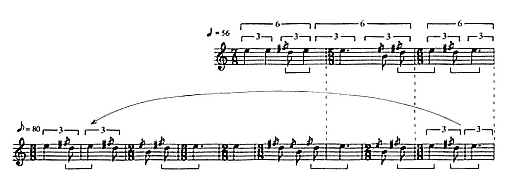
Example 21:
Les Noces
More eventful from the standpoint of fixed metric identity is the tiny D-E segment. Marked off by brackets underneath both versions of Block A in Example 21, D-E is a part of E-D-E and of subsequent extensions of this motive as well. Returns to E invariably come by way of D, and the succession is stressed by a doubling in the cello in the early draft (see Example 19) and by octave doublings in Pianos I and III in the final version (see Example 23). Notice, however, that in accord with the longer measures of the early draft, D-E is barred differently on each occasion, while, in the finished score, D-E is always barred as an over-the-barline succession; irrespective of the notated irregularity, D-E assumes the same metric identity. Hence, just as with the E-D-E motive, the finished score latches on to a fixed element or constancy, here in the form of the smaller but more pervasive D-E component. In addition, E, as the registrally fixed pitch of departure and return, always falls on the first beats of the irregular measures. Indeed, as can now readily be seen, the notated irregularity of the final arrangement is in large part determined by these metrically fixed components; they tend, as it were, to regulate the irregularity . The shifting meter seeks, at least in part, to preserve fixed identity in repetition.
A summary of these conclusions appears in Example 22, where a hypothetical scheme further demonstrates just how regular the irregularity is. Observe how the shifting meter revolves around the fixed components, and in particular the over-the-barline identity of D-E. Indeed, according to the hypothesized version, Block A contains only three motivically defined metrical units: a



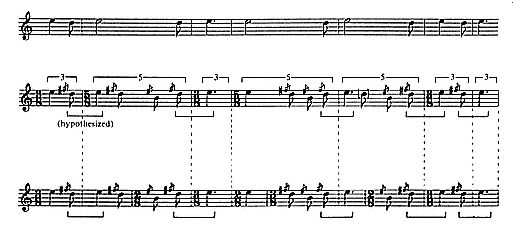
Example 22:
Les Noces
bar for E-D-B-D. And if we omit the dotted quarter-note, the scheme reduces to only two such units: E-D-(E) and an extension in the form of E-D-B-D-(E). (In the fifth bar of the hypothetical version, the dot of the quarter-note must yield to D as an eighth-note [marked by parentheses] to allow for complete motivic correlation.) So, too, there are only







Notice, too, that the natural stresses of the Russian syllables underscore D-E as a metrically fixed unit in the final version.[35] As is shown by the stress markings for Block A in Example 20, these stresses coincide with the (musically) stressed D of the D-E unit for all D-E repeats except the final two. In contrast, the repeats of D-E in the draft (Example 19), although doubled by a solo cello, lack this support. In view of the tradition of flexible accentuation in the singing of Russian popular verse, the coincidence here of natural stress and musical accent (for the upbeat D of the D-E unit) takes on an obvious significance.[36] A peculiarly Stravinskian trait in these opening passages is the stutter effect, the repeat, in the fourth and fifth measures of the final version, of the individual syllable ko of Kosal ', meaning "braid." Within the framework of a bride's ritualized lament, the stutter suggests a sob or sigh.
Up to this point the logic of the barring has been pursued solely from the standpoint of metrically fixed elements. What may be termed the opposite
[35] A translation of the two lines of Blocks A and B runs as follows: "Braid, my dear little blond braid!/Yesterday my mother braided you, my dear little braid, my mother braided you!" Most of the libretto of Les Noces was adopted from P. V. Kireevsky's anthology of peasant wedding verses: V. F. Miller and M. N. Speransky, eds., Pesni sobrannye P. V. Kireevskim, Novaia seriia , vol. 1 (Moscow, 1911). I am indebted to Simon Karlinsky for his assistance in the translation and transliteration of the above text.
[36] An early discussion of the flexible or "movable" accent in Russian folk songs is contained in the Introduction to Eugenie Lineff, The Peasant Songs of Great Russia , vol. 1 (St. Petersburg, 1905), pp. xvi–xvii. In Igor Stravinsky and Robert Craft, Expositions and Developments (Berkeley: University of California Press, 1981), p. 121, the composer recalled that his own conscious recognition of this feature had come as a "rejoicing discovery" while working on the libretto of Renard : "One important characteristic of Russian popular verse is that the accents of the spoken verse are ignored when the verse is sung. The recognition of the musical possibilities inherent in this fact was one of the most rejoicing discoveries of my life." It need in this connection hardly be reiterated that this folk-song tradition of flexibility in verbal stress is analogous to the musical technique of displacement, of shifting the accentual identity of a reiterating fragment, and that the latter may well have had the former as its origin. At the same time, and as will presently be made clear, the technique of displacement always carries with it the opposing force of fixed metric identity, an element which lies at the root of metric irregularity in Stravinsky's music. Both the flexible stress in Russian popular verse and its implications in Stravinsky's early vocal music are pursued in illuminating detail in Richard Taruskin, "Stravinsky's 'Rejoicing Discovery' and What It Meant: Some Observations on His Russian Text-Setting," in Ethan Haimo and Paul Johnson, eds., Stravinsky Retrospectives (Lincoln: University of Nebraska Press, forthcoming).
side of this rather elaborate coin—the opposite side, that is, of fixed metric identity or constancy—is "displacement," the notion of a "modification of accents," as Adorno expressed it—presumably, metrical accents. For, as can readily be seen from the irregular barring of the finished score, displacement is not here graphically a part of the invention. On the contrary, and as suggested, each of the designated components assumes, in relation to the shifting meter, a fixed identity: E-D-(E) is barred as a

There is little difficulty in rearranging the opening blocks of Les Noces accordingly. As is indicated by the brackets in Example 23, a

Thus, in the opening two measures, the stressed D-E succession falls on the third beat of the


[37] In Lerdahl and Jackendoff, A Generative Theory of Tonal Music , p. 17, the term phenomenal accent is used to distinguish local stresses such as sforzandi, long notes, and leaps from metrical and structural accents. Earlier, in Grosvenor Cooper and Leonard B. Meyer, The Rhythmic Structure of Music (Chicago: University of Chicago Press, 1960), p. 8, stress is defined as "a dynamic intensification of the beat."
junction with the return of the E-D-E motive in the final bars of the block. Moreover, the


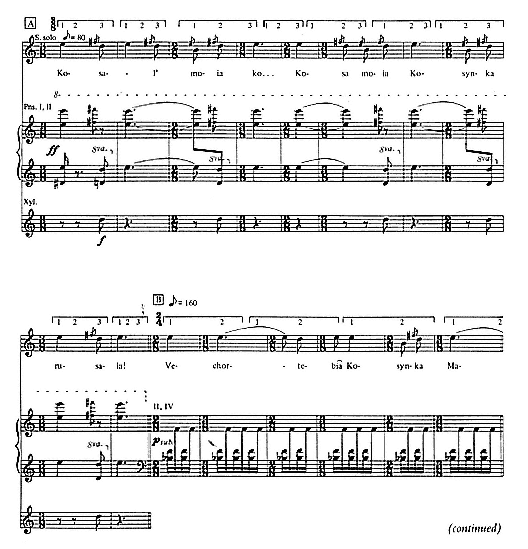
Example 23:
Les Noces
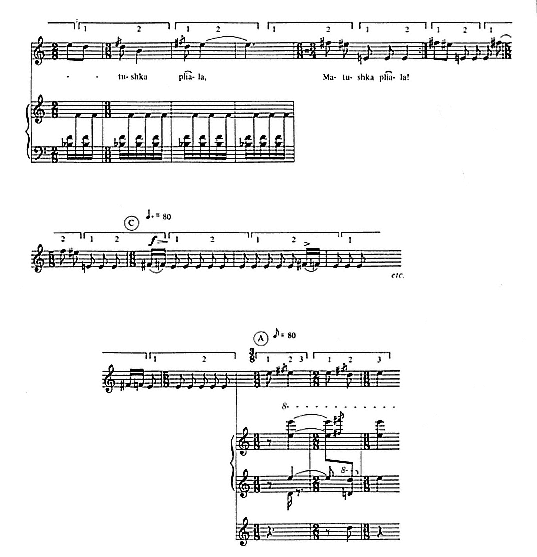
Example 23
(continued)
Similar inferences may be drawn from the material of Block B. Here, however, the periodicity is duple rather than triple. Moreover, the foreground irregularity comes by way of a subtactus unit, while in Block A it surfaces by way of the tactus. In other words, while Stravinsky doubles the marking for the eighth-note from 80 to 160 at Block B, the listener is far more apt to hold on to the marking of 80, which becomes the marking for the
quarter-note (as tactus). And with the eighth-note relegated to a subtactus unit (and given, as well, the brevity of Block B in relation to Block A), the


With Block C the dotted quarter-note is given the marking of 80, which in turn stipulates a triple division of the retained pulse. And while the stressed F


















Example 24 re-bars the material of Blocks A and B in accord with the



Example 24:
Les Noces (re-barred)
Histoire du soldat (1918)
Other contexts can illuminate the present perspective more fully. Most compelling among these are passages of irregular barring in which a steady meter, as forcibly applied to the opening blocks of Les Noces, surfaces more explicitly in the guise of an ostinato, generally in the bass. Such passages abound in Stravinsky's music, of course. The opening "Soldier's March" of Histoire du soldat is a particularly apt example, if only because the habit of applying "smaller divisions" had by the time of its completion reached a decisive formulation. Moreover, the disruptive


The disruptive content of Histoire 's March can be traced to the marching tune's B-C




Similar implications can be applied to the terminating E of the sweep which, like the E in the opening blocks of Les Noces , functions as a melodic point of departure and return. Indeed, there is an obvious correspondence here between the over-the-barline D-E succession of Les Noces and the B-C



This is especially true of the climactic passage at mm. 50–57, as shown in Example 25d. In Example 25a, these motivic components are introduced with a minimum of disturbance. Here metric identity is first established in relation to the ostinato's







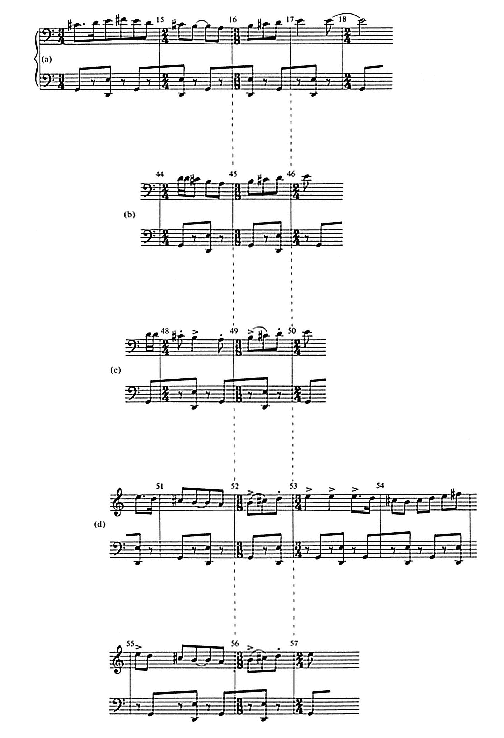
Example 25:
Histoire du soldat
at m. 17 is likely to be heard as an offbeat element, a syncopation pursuant to the steady

Moreover, at mm. 45–46 in Example 25b, this identity is not markedly affected. For while B-C





Finally, at mm. 50–57 in Example 25d these conflicting identities are presented successively in a final, tutti summation. In the first occurrence, at mm. 52–53, the initial offbeat identity of the terminating E is restored; in accord with the







In other words, the sense of a "true" metric identity for the B-C


Nonetheless, in direct opposition to displacement, the irregular barring
stubbornly preserves fixed metric identity. In Historie 's March, B-C




The double edge here is critical. On the one hand there is a form of displacement, an effort to contradict the accentual identity of a reiterating fragment (which presupposes steady metric periodicity, even if of the concealed, background type as bracketed or re-barred in the preceding examples), and, on the other hand, there is an effort to counter this displacement by pressing for a fixed metric identity in repetition. And if the strategy does in fact entail an element of "sadism," this can perhaps best be heard and understood as it relates to counteraction, to the attempt to press for a sameness in the repetition of a fragment (and often, in effect, a static, downbeating kind of sameness), to compose, indeed, as if the repetition were metrically genuine.
Still, questions may linger about the ultimate effectiveness of counteraction, of fixed metric identity in repetition and as it here entails the integrity of the preserved








analytical, designed to uncover the concealed side of the double edge, not to serve as a substitute for the printed page.
Indeed, as is in this respect sufficiently evident, Stravinsky himself was a radical interpreter of his music. And as a conductor he favored a strict adherence to the bar line, a fact borne out today by a number of recorded rehearsals[39] and by the following excerpt from Conversations with Stravinsky . Here, of course, accent means phenomenal accent or stress.
R. C.: Meters. Can the same effect be achieved by means of accents as by varying the meters? What are bar lines?
I. S.: To the first question my answer is, up to a point, yes, but that point is the degree of real regularity in the music. The bar line is much, much more than a mere accent, and I don't believe that it can be simulated by an accent, at least not in my music.[40]
Yet it seems inconceivable that he could have been oblivious to the contradictions in the metric identity of the reiterating components that, hinging on a steady periodicity, lie concealed beneath the imposition of a foreground irregularity. The shifting meter can acknowledge only one side of the coin, only one side of the double edge, namely, counteraction, the effort to render the repetition as metrical sameness. And such an effort can be appreciated only in relation to the current against which it is directed. The surface of this music may be radical, but its meaning is subject to a deeply conservative grain of musical thought.
A passage from Oedipus Rex (1926) serves as a final illustration. Shown in Example 26, a melodic fragment is introduced at no. 139 and is then repeated at no. 140. Of course, as in previous examples, the repeat harbors a contradiction. For in accord with a concealed


[40] Igor Stravinsky and Robert Craft, Conversations with Stravinsky (Berkeley: University of California Press, 1980), p. 21.
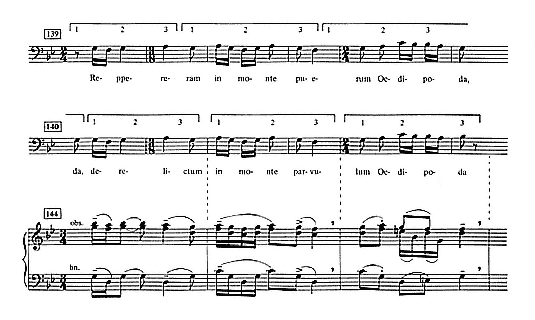
Example 26:
Oedipus Rex
"Evocation of the Ancestors"
It will be remembered that the "Evocation" consisted of two alternating blocks of material, the first of which spaced or marked off successive appearances of the second, principal block. Attention will here be focused primarily on the second of these two alternating blocks, henceforth designated Block B.
At issue are (1) fixed metric identity and (2) displacement. These, of course, are the twin sides of the double edge or coin referred to above. However, in the "Evocation" the second of these edges surfaces with an inconvenient hitch: at strategic points of arrival and departure, the background periodicity upon which felt displacement hinges does not, as in the previous illustrations, flatten out the foreground irregularity. Except for the initial statement of Block B at no. 121 + 3, the periodic grain that may be inferred does not as a rule arrive on target with the shifting meter as subsequent Block B statements are concluded. At the same time, the "feel" of periodicity is inescapable. In the 1929 revision the half-note is initially the tactus with an assigned marking of 72. And with the half-note-quarter-quarter motive of Block B's initial bar, a


fixed metric identity, as defined by subsequent repeats of the initial motives and submotives of Block B, to comply.
This, of course, is the familiar twist of the double edge. Yet for the reasons indicated already, hidden periodicity seems here at a greater disadvantage than in the passages examined from Les Noces and Histoire, so that, in turn, displacement in the metric identity of the reiterating motives may not be as acutely felt. With subsequent repeats of Block B's initial motives, the listener is more apt to readjust his/her metrical bearings than to persevere with the diminishing traces of a prevailing periodicity. Hence the opposing forces of fixed identity and displacement are placed in a more balanced relationship. For the conservative listener, the radical implications of the shifting meter are more persuasively brought to the fore.
Shown in Examples 27a–27c are three versions of Block B's initial statement at no. 121 + 3. These are drawn from page 73 of the sketchbook, the 1913 autograph, and the 1929 revision. As reported earlier, the sevens of the sketchbook version were carved up into two units of 4 + 3 quarter-note beats in the 1913 autograph. Highlighted in particular in the autograph is the underlying repeat structure of the initial B statement. For while motive a7 is shortened by two notes at m.4, the initial 4 + 3 unit is retained. (The deleted notes are bracketed in Example 27b, where the a7 label is retained for the repeat.) Hence, motivically speaking, modified restatements of Block B derive in their entirety from the single motive a7 and its 4 + 3 subdivision. All subsequent extensions, contractions, and reorderings materialize with reference to this single motivic point of departure.
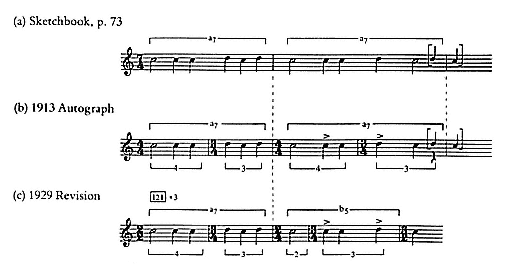
Example 27:
"Evocation"
In contrast, the barring of the 1929 revision records the actual shortening of motive a7 at mm.3-4. As shown in Example 27c, the final C falls on the downbeat at m.5. And since the downbeat here coincides with the return of Block A, the C is placed in a parallel relationship with the earlier C at m.3. This in turn underscores a more separately realized identity for the repeat (labeled b5 in Example 27c), whose 2 + 3 subdivision will in turn differ from that of a7. In addition to a


This does not suggest, of course, that the repeat structure of a7 followed by b5, as graphically exposed by the autograph version, is entirely obscured. On the contrary, a7 still contains b5, while, as boxed off in Example 28, a single inflection, the D, acts as a kind of pivot in distinguishing subsequent repeats of the two motives. Indeed, by including the final C in the motivic definition, the boxed-off D in Example 28 divides Block B into two equal units of six quarter-note beats.
And in this way, too, the "Evocation" emerges as yet another illustration of that earlier noted addiction to pitch-stutter, to "a ceaseless alternation between two or three notes," here in the reduced form of a punctuation of C and its inflection D. Correspondences with the above-noted passages need hardly be cited in this connection. Yet perhaps especially in the "Evocation," the very idea that so much could in fact have been made of so little presses itself on the imagination to a degree quite without equal among the many other, similarly disposed passages in this oeuvre .
Two restatements of Block B are shown in Examples 29 and 30. These feature extensions and reshufflings of the original a7–b5 motivic order as introduced at no. 121 + 3. In addition, there are hinges in these lengthier statements, slight infractions in terms of C-E



Example 28:
"Evocation"
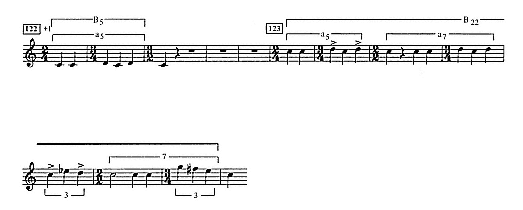
Example 29:
"Evocation"
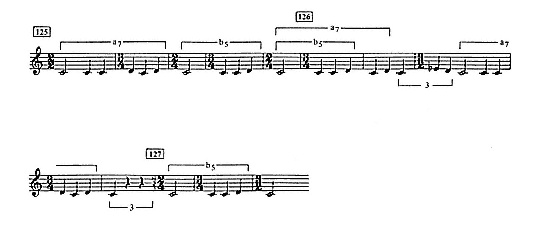
Example 30:
"Evocation"
Most extensive among these restatements, however, is that at nos. 125-27 + 1. Shown in Example 30, this begins with a recapitulation of the original a7–b5 order, which is followed by a b5/a7 overlap; the barring here of b5 conceals the longer a7 repeat, which is then extended by the C-E

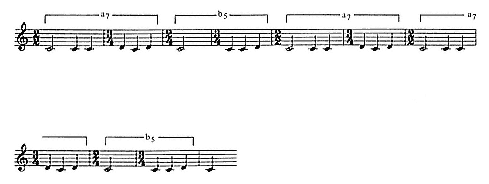
Example 31:
"Evocation" (hypothetical version)
culiar tension of these measures cannot be said entirely to reside in the repetition of a string of unchanging motives. For instance, at nos. 125-26 in Example 30, to what extent is the second of the two successive b5's heard and understood as a "true" repeat of the first? Or in the recomposed version in Example 31, in what sense is the second of the two successive a 7's perceived as a straightforward repeat of the first? The point seems to be that these repeats raise expectations of periodicity that, in a delicate balance between compliance and forced readjustment, are subtly either affirmed or rebuffed by subsequent motivic placement.
As was mentioned already, similar inferences may be drawn from the initial a7-b5 succession itself at no. 121 + 3. For with the half-note as the tactus, the opening bars initiate a


Here again the exposed repeat structure of the autograph version is instructive. As outlined in Examples 32a and b, the two sevens and their 4 + 3 subdivisions are a condensation, by one quarter-note beat for each 4 + 3 unit, of a square metrical scheme of two eights with subdivisions of 4 + 4. In other words, with the initial motive a7, a square periodic 4 + 4 unit is squeezed into an "irrational" one of 4 + 3; at m.3, the shortened repeat of a7 arrives one quarter-note beat too soon. And with the shrinkage of this 4 + 4 unit to 4 + 3, pressure tends to accumulate precisely at the juncture of the motivic repeats, that is, at the half-note C that invariably initiates repeats of both a7 and b5. (Note that the half-note C always falls on the downbeats of the irregular measures.) Thus while the initial C at m.3 serves first and foremost as the start of
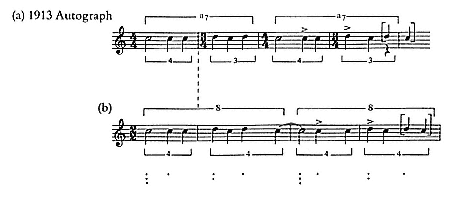
Example 32:
"Evocation"
the shortened repeat motive, it never entirely severs its ties to a7 as a terminating element; at m.3, a7 is cut short and remains in this respect unfulfilled. (The impact of the condensation could be represented by an interminable succession of elision loops at the juncture of all a7/b5 repeats.) Hence the motivic repetition of Block B assumes, built in from the start, a tight, breathless quality. Always arriving a bit too soon, the repeats within a particular succession appear hurried and impatiently realized, always lacking the sense of a true rhythmic finality or resolution.
The second of the two factors mentioned above concerns b5 as a contradiction of a7. For with the trimming of 4 + 4 to an "irrational" count of 4 + 3, the shortened b5 repeat at m.3 assumes, in relation to a7, a syncopated identity. In accord with the



A final step in this analysis is to situate these findings within the wider context of the two alternating Blocks A and B. Shown in Example 34, the total quarter-note count for Block B is twelve. And Block B is flanked by A
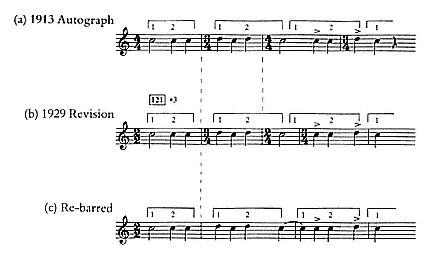
Example 33:
"Evocation"
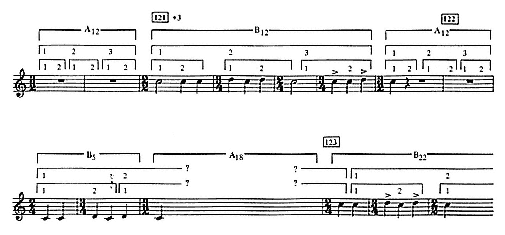
Example 34:
"Evocation"
statements whose



on the second, as earlier at no. 121 + 3. Moreover, the


Of course, it could easily be argued that at the higher level of structure in Example 34, the 1-2-3 triple count of Block B at no. 121 + 3 is inherently unstable. For quite apart from the many psychological and physiological points that have traditionally been raised in support of the thesis of an innate duple preference in situations of this kind, Block B is an abbreviation of a conventional duple scheme.[41] As was shown already in Examples 32a and 32b, the 7 + 7 and 7 + 5 schemes of the autograph and 1929 revision are a condensation of a square 8 + 8 scheme, so that, at the higher level in the 1929 revision, a potential 1-2-1-2 count shrinks to 1-2-3. Yet a duple alternative at this level at no. 121 + 3 would not appreciably have altered the disruptive effect as sketched in Example 34 on behalf of the triple mold. Beginning with the downbeat at no. 121 + 3, the entrance of a5 in the echo statement at no. 122 + 1 would still have fallen "incorrectly" on a first, "strong" beat.
In Example 35 these implications are applied to the lengthy B statement at nos. 125-27 + 1. Here, a 1-2 duple scheme is pursued at two levels of structure while, underneath the excerpt, the brackets indicate the motivic repeats and hinges as surveyed in Example 30. And as is evident, the first major point of reckoning comes with motive a7 in the



[41] Reflections on binary intuition can be traced back to the Renaissance theorist Franchinis Gafurius (1451–1522), Practica Musicae , trans. Irwin Young (Madison: University of Wisconsin Press, 1969). More recently, correspondences have been drawn between the binary count and automatic functions such as breathing and walking. Schenker invoked "the principle of systole and diastole inherent in our very being" as part of his argument regarding the "natural" two-ness of metrical structures. See Heinrich Schenker, Free Composition (Der Freie Satz) , trans. Ernst Oster (New York: Longman, 1979), p. 119. In Lerdahl and Jack-endoff, A Generative Theory of Tonal Music , p. 101, the duple bias is introduced as a "metrical preference rule" regarding higher levels of structure in tonal music. It is discussed briefly and then dismissed in a different context in David Lewin, "Some Investigations into Foreground Rhythmic and Metric Patterning," in Richmond Browne, ed., Music Theory: Special Topics (New York: Academic Press, 1981), pp. 101–3.
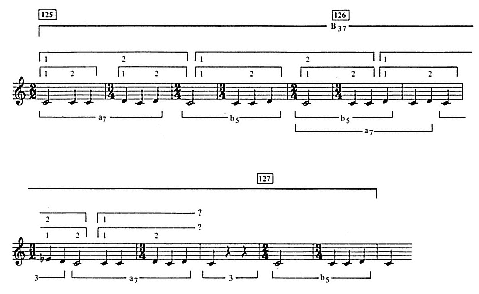
Example 35:
"Evocation"
target with the irregular barring as the entire block draws to a close two measures later.[42]
As a final illustration, an outline of the "Evocation" as a whole is sketched in Chart 1. Here, of course, the design is similar to those introduced by Boulez in his extensive discussion of The Rite .[43] Note the sequential character of the format; within the alternation between Blocks A and B, principal statements of B alternate with the shorter echo statements. In addition, the echo statements retain a stable duration of five quarter-note beats for the condensed motive a5, while the remaining, principal statements expand from twelve to twenty-two and finally to thirty-seven beats in the lengthy block surveyed in Example 35. But as should by now be apparent, the perceptual implications of these measurements are far from "abstract." Heard and understood with reference to the double edge of fixed metric identity and displacement, they take on a lively sense of the "play" of this invention, its true raison d'être .
[43] Boulez, Notes of an Apprenticeship , pp. 72–145. The most detailed analyses are those of the "Dance of the Earth," the "Glorification of the Chosen One," and the "Sacrificial Dance." Boulez ignored the "Evocation" altogether.
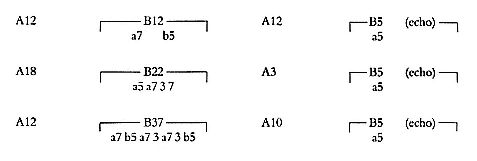
Chart 1:
"Evocation"
"Sacrificial Dance"
The kind of repeat structure that initiates Block B in the "Evocation" is by no means unique to this single movement. Similar configurations are found in the opening two bars of the "Ritual of the Rival Tribes," in the first two


In Example 36 attention is drawn to the two principal motives a and b (labeled cells by Boulez).[44] And, as in Example 25 from the March of Histoire, subsequent repeats of these two units are aligned vertically and then marked off by dotted lines. Thus, too, fixed metric identity imposes itself along familiar lines. For notwithstanding the irregular


Still, with the eighth-note inferred initially as the tactus with an assigned tempo marking of 126, a concealed


[44] Ibid., pp. 124–27.
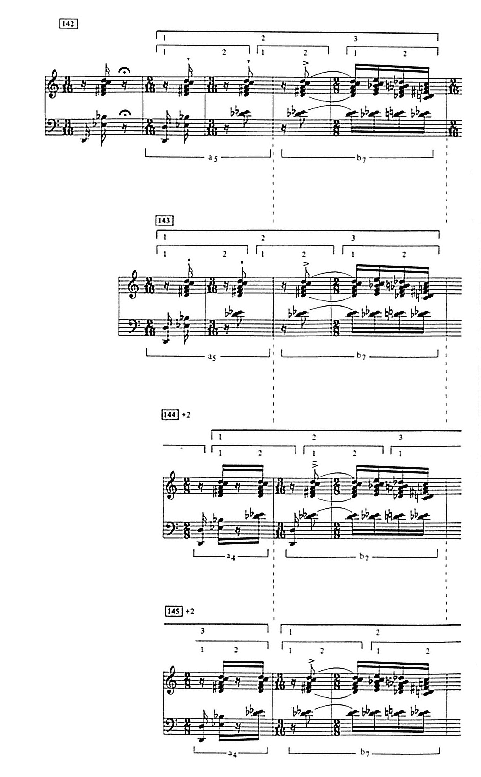
Example 36:
"Sacrificial Dance"
initial identity is established for motive b7 at nos. 142 and 143, which at no. 144 + 4 is displaced by an eighth-note beat, the reversal thus coming by way of the tactus. Finally, at no. 145 + 4 the displacement surfaces more conspicuously in the form of an offbeat-onbeat contradiction, and from this point on the struggle of fixed metric identity and displacement assumes its relentless and by now celebrated disposition.
Of course, the "Sacrificial Dance" does not have the convenience of a basso ostinato. And without question the impact of the disruption, of a periodicity constantly lost to the modification and reshuffling of the metrically fixed elements, is ultimately far more severe, far more disorienting. Yet the strategy itself remains unchanged. Even the more active role of the percussion in the climactic section at nos. 146–48 can revealingly be compared to the climactic stretch at mm. 50–57 in Historie , as examined and discussed apropos of Example 25d.
A Conclusion
As a final suggestion it should again be noted that the "play" or double edge of Stravinsky's invention is not as new or as exceptional as might at first be imagined. For if, in past tonal music, measures were routinely added or deleted at higher levels of metrical structure with expectations of periodicity, disruption, and readjustment, then it can be seen that in Stravinsky's case these same processes were merely shifted to different and more immediate structural levels. Thus, to take a famous example already cited, in the first movement of Mozart's G Minor Symphony thematic statements are introduced at m.1 and m.20, so that, at some point in these first twenty measures, the two-measure module is broken as the accents at this level shift from the odd- to the even-numbered measures.[45] And in the first movement of Beethoven's Piano Sonata in D Major, Op. 10, No. 3, the repeat of the entire exposition can be heard and understood as embodying a similar contradiction or reversal at the two-measure level, with the accents at the even-numbered measures shifting to the odd-numbered measures at some point during the exposition.[46]
To be sure, the invention with Stravinsky presumes a new concept of motivic repetition, of harmony and formal outline. Yet the relationship here is important, because it points again to underlying assumptions of conventional dance periodicity. So, too, the radical-conservative dichotomy in perception shifts to another level of metrical structure.
[45] See Lerdahl and Jackendoff, A Generative Theory of Tonal Music , pp. 23–25.
[46] See Imbrie, "'Extra' Measures and Metrical Ambiguity in Beethoven," pp. 45–51.